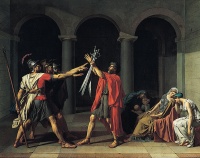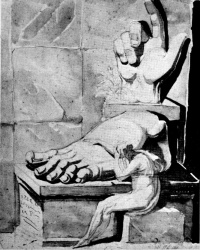Neo-classical painting
From The Art and Popular Culture Encyclopedia

|
"A reflection of the more serious mood of the day is to be discerned in an earnestness and a severity that was finding its ideal in classical subjects. Attention had already been turned in that direction by the excavations at Pompeii (1755), by the publication of Winckelmann’s History of Art among the Ancients , the first ever written on the subject, and by the popularity of Piranesi’s engravings of Roman buildings. Hence it is not surprising that the pictures of the classicists, such as the Oath of the Horatii (Louvre) by Jacques Louis David (1748-1825), were received with great enthusiasm. In contrast to the lilting rhythms and melting color of rococo, the cold harsh art of David, linear, drab, almost monochrome, and sculptural in feeling, furnished a gratifying change and a mood that was apposite to the changing temper of the times. "--Gardner's Art Through the Ages (1926) by Helen Gardner |

|
Related e |
|
Featured: |
Neo-classical painting was a European art movement which began in the 1760s, as a reaction against both the surviving Baroque and Rococo styles, and as a desire to return to the perceived "purity" of the arts of Rome, the more vague perception ("ideal") of Ancient Greek arts, and, to a lesser extent, 16th century Renaissance Classicism.
Contrasting with the Baroque and the Rococo, Neo-classical paintings are devoid of pastel colors and haziness; instead, they have sharp colors with Chiaroscuro. In the case of Neo-classicism in France, a prime example is Jacques Louis David whose paintings often use Greek elements to extol the French Revolution's virtues (state before family).
Neoclassicism continued to be a major force in academic art through the 19th century and beyond—a constant antithesis to Romanticism or Gothic revivals— although from the late 19th century on it had often been considered anti-modern, or even reactionary, in influential critical circles. Its final strains were to be found in exotic painting.
Technique
Oath of the Horatii shows the neoclassical painting style, and employs various techniques that were typical for it:
- The background is de-emphasized, while the figures in the foreground are emphasized to show their importance.
- The use of dull colors is to show the importance of the story behind the painting over the painting itself.
- The picture is clearly organized, depicting the symbolism of the number three and of the moment itself.
- The focus on clear, hard details and the lack of use of the more wispy brushstrokes preferred by Rococo art.
- The brushstrokes are invisible, to show that the painting is more important compared to the artist
- The men are all depicted with straight lines mirroring the columns in the background signifying their rigidity and strength while the women are all curved like the arches which are held up by the columns.
- The use of straight lines to depict strength is also demonstrated in the swords, two of which are curved while one is straight foreshadowing that only one brother would survive the encounter.
- The brother closest to the viewer (presumably destined to be the sole survivor) is dressed in colors matching that of the father while the garb of the other brothers is obscured but seems to mimic the colors being worn by the women.
- The frozen quality of the painting is also intended to emphasize rationality, unlike the Rococo style.
- The only emotion shown is from the women, who were allowed to feel, while it was for the men to do their duty with heroic determination.
- The fact that it also depicts a morally complex or disturbing story lends to its classification as a neoclassical work.
See also

